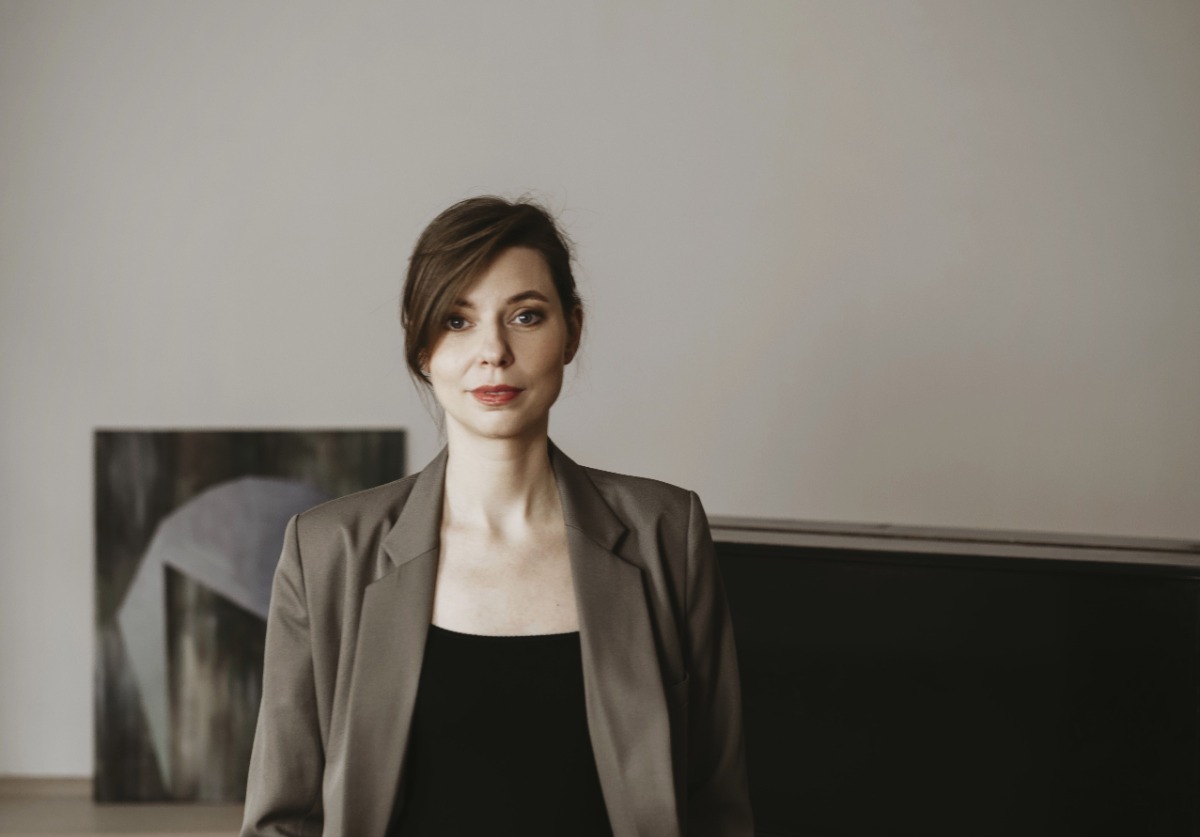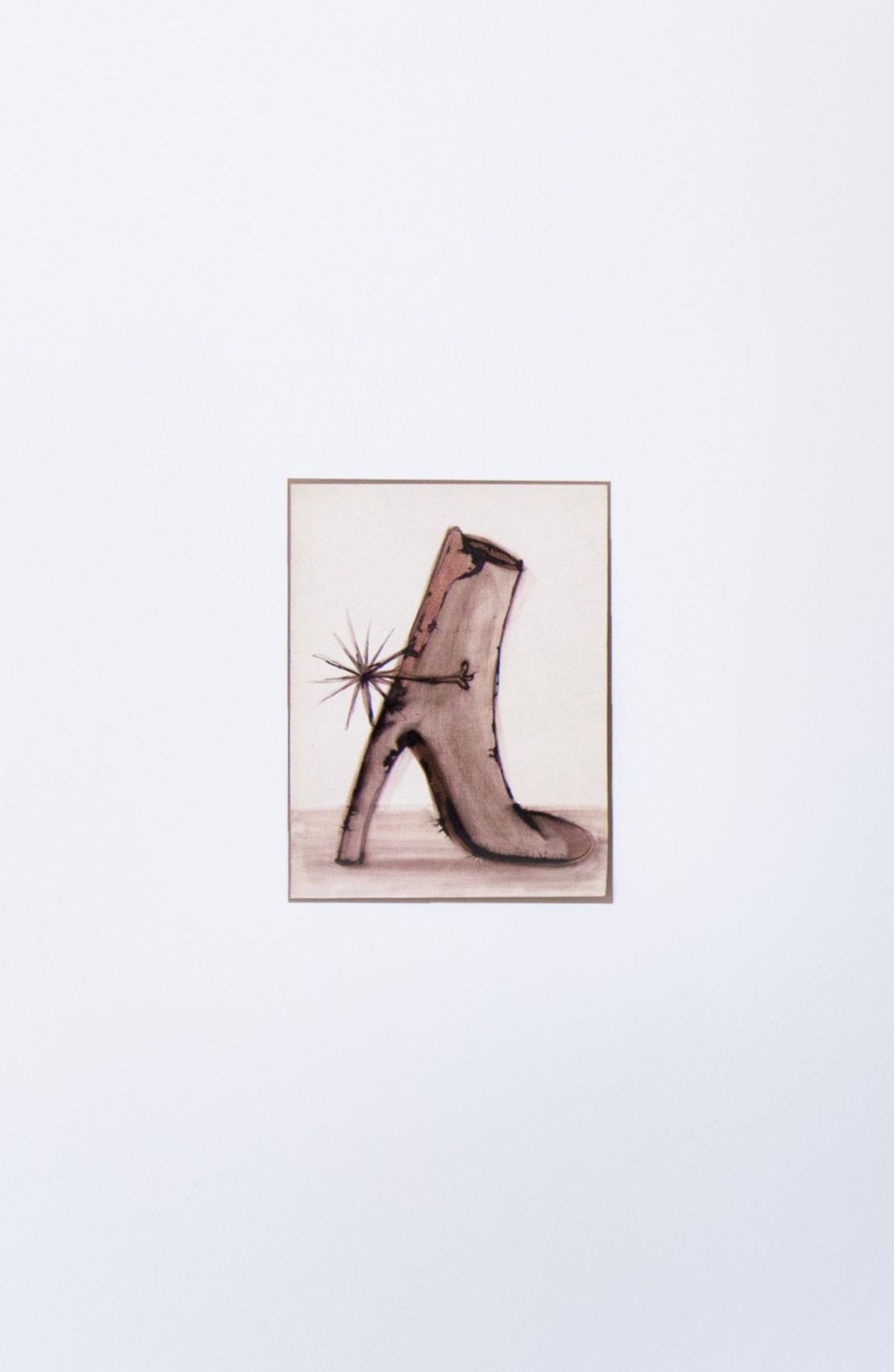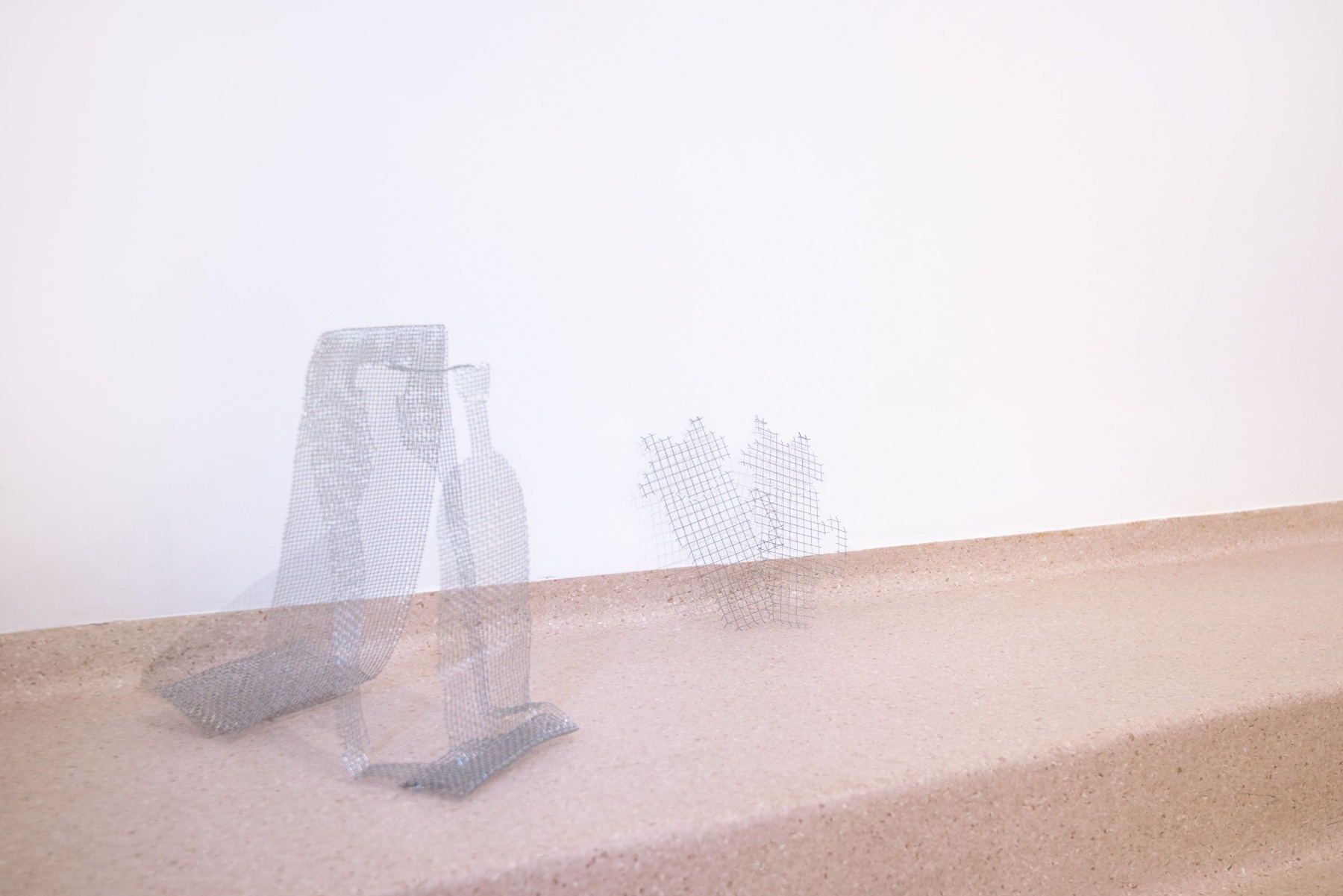
The aesthetics of constant change
An interview with Jolanta Laurent, the founder of Drifts gallery in Vilnius
At the last year came to a close, a new gallery popped up on the Vilnius art scene – the Drifts gallery. The gallery is located next to the Vrublevskiu Library of the Lithuanian Academy of Sciences, and its first group show, Drifts, was presented on December 15, 2022. Linings, the exhibition of Vytenis Burokas on view until April 22, is the gallery’s first solo show. The exhibition consists of previously unexhibited Burokas drawings produced between 2019 and 2023, as well as prints and sculptural objects created for this show. As its curator, Edgaras Gerasimovičius, writes in the exhibition text: “In the exhibition, the usual main character of Burokas’ artistic practice is represented by an excessive autonomy of his attributes – hairstyles, shoes, drinks. References to Andy Warhol’s early work and Sergei Eisenstein’s notes on Walt Disney’s working methods place the artworks in a broader context. Both the expositional equipment and the exhibition space connect with the works exhibited in a kind of “conspiration”: as if repeating the contours of an already existing drawing in imprecise lines, they mock the conventions of artwork and exhibition production, the magic of the artist’s hand creating ex nihilo, and the importance of artworks in today’s consumerist economy.”
Besides exhibitions, the Drifts gallery runs a programme tailored to collectors – from experienced art-lovers to everyone who still wishes to become a collector – featuring Lithuanian and international artists and organising studio visits, talks and art events.
As Jolanta Laurent, the founder of the gallery, reveals in her interview with Arterritory, the name of the gallery is borrowed from the 2020 novel of the same name, written by Kate Zambreno. “She wrote her novel allowing herself to be carried by the flow of everyday life and its multivarious manifestations, engaging in intimate inner dialogues with artworks and portraits of famous artists. I, too, was captured by this flow and the aesthetics of constant change. So I borrowed the name, willing to collect these crumbs of everyday life, the fragments of thoughts and experiences through the art of now.”
Group show "Drifts". Exhibition views at the Drifts gallery, Vilnius. Photos: Vaida Jonušytė
Could you describe the concept and vision of the Drifts gallery, what makes it unique? And where is it drifting to?
Art makes it unique. I was thinking a lot about a gallery’s role and function in the constellation of today’s cultural institutions. Here in Vilnius we have a rich and dynamic artistic scene with many initiatives and projects. However, I was always fascinated by the ‘coin effect’ – art needs viewers and collectors – and the gallery is the place where the artist’s world meets the viewer’s gaze and experience.
There were lots of changes and silences in my life during the previous five years – birth and death played significant roles, too. This gave me the strength and the awareness of the beauty of change. When I finally decided to go on my own, to look for the form and how to name it, I remembered the novel Drifts (2020) by Kate Zambreno. The author was obsessed with the present and the challenges of writing about the present tense. She wrote her novel allowing herself to be carried by the flow of everyday life and its multivarious manifestations, engaging in intimate inner dialogues with artworks and portraits of famous artists. I, too, was captured by this flow and the aesthetics of constant change. So I borrowed the name, willing to collect these crumbs of everyday life, the fragments of thoughts and experiences through the art of now.
I wish to create a gallery with a strong and beautiful voice of our present times, to create a place for people who are as passionate about art as I am.


How did you choose the location for the gallery?
The search for a location was a long process demanding a lot of patience. I started during the pandemic, and then suddenly the war hit. From the very beginning, I knew I wanted to find accessible premises on the first floor with high ceilings and a historical approach. It took over a year to find a place where the main criteria aligned with my vision for the gallery.
At first, the area around the train station and Naujamiestis looked like the most interesting and affordable location. However, establishing the gallery there meant having to adapt to the dynamic and artistic pulse which already existed there. I was not sure I wanted to adapt myself, although I had felt so close to this rhythm. Finally, I found a spot for the gallery at the edge of the Wroblewski Library, near Cathedral Square in the heart of Vilnius.
I’m very interested in the theories of curating contemporaneity and the history of collecting – these two came up once I entered the future gallery’s premises. I like the place because this area has a very rich and beautiful history where collecting, exhibiting and museology practices intertwine. I like the place because it is so depersonalised and transitional, surrounded by tourist architecture turning itself into the real archetype of a passers-by space – the theories of contemporaneity are fostered in here.
Moreover, it is important for me to stay in touch with the Academy, which is just on the other side of Cathedral Square. Other galleries, project spaces, museums and an art foundation are also easily reachable from here.

How would you comment on the choice of artists represented by the Drifts gallery? What do you look for when considering a new artist for your gallery?
I wanted to bring something new with some different approaches. I’m not focused on certain media, nationalities, or concepts. The most important thing for me is that the idea and form are in synergy in creating appealing art. Yet I cannot escape from my personal and subjective choices, and thus I am always in conversation with other art historians and curators.
The first solo-curated exhibition, by Vytenis Burokas, came from the desire to explore and reveal his drawings more than they have been up to this point. The way he thinks and merges different disciplines in constructing new forms and perspectives to look at art always triggers and always surprises. He is very well known for his sculptural objects, installations and performances, and his works are widely exhibited (FUTURA, MOCAK, CAC, etc.), but his drawings remained sporadically presented, so I wanted to bring focus to them.
The second solo exhibition, also solo-curated, will be by Agnė Juodvalkytė, a Lithuanian artist based in Berlin. She will have her first solo exhibition in the Baltics although her works are successfully exhibiting in Germany, Denmark and Austria. Her practice is focused on abstract painting and textiles – she uses the textile as a framework to understand culture, history and technology. I’m obsessed by the beautiful flow of rituals in her works, the symbiosis of colour and light.
For this year’s gallery programme, I also plan to bring a solo show by the young photographer Janina Sabaliauskaite, who is based in Newcastle upon Tyne. Her works look at the history of feminism and LGBTQ+ visibility, and address issues of identity, gender, sexuality and desire. She recently had a solo show at the Northern Gallery for Contemporary Art in Sunderland. This is going to be her first solo presentation in the Baltics as well.
Moreover, I’m eager to give the gallery’s platform to young artists who are still studying or have just finished their studies, among them Ieva Rižė, Šarūnas Baltrukonis, Mantas Valentukonis and Agata Orlovska. I am interested in their experimental thinking, their individual approach to the media, and their doubts and discoveries.
This year’s programme is very much focused on Lithuanian artists, but my wish in the future is to expand the programme to artists from abroad.


The Drifts gallery is also running a programme tailored especially to collectors. Could you elaborate a bit on that? Is it focused mainly on Baltic collectors, or are you also working with international collectors?
Together with a professionally built gallery programme, I would like to share my passion for collecting. I believe collecting is a journey through knowledge, and then objects. Therefore, I want to create an atmosphere for sharing this knowledge and experience, to think about local and international peculiarities for collecting, and to reflect on collecting history and its impact on today’s practices. The programme of talks and art events will be presented shortly.
I’ve chosen to be a hybrid gallery – to have physical exhibitions, to be a place to go to, and to be a virtual space where I could introduce Viewing rooms presenting artists and their works in depth.
My goal is to establish the gallery locally and create a supporting art community around it. I don’t believe national boundaries count a lot in these times, but of course, certain challenges remain in order to reach the broader international collectors’ scene. My dreams are in there, for sure.

What do you think makes the art scene in Vilnius unique, and what is the current role of commercial galleries in the fabric of the scene?
The art scene in Vilnius is vibrant and very productive. I quite agree with curator Ory Dessau in that we have a strong Lithuanian identity in the arts. I think this is unique and still could be very interesting for the international art scene to experience.
I think the role of the gallery hasn’t changed a lot – it is still very classical in structure, but flexible and able to adapt itself in present contexts. The gallery is an intermediary between the artists and the wider conversation. Galleries support and promote their artists, they sell artworks. Of course, there are much more visible and invisible functions, but the essence, I think, is to build the community around it, be the bridge for connections and conversations, carry and advocate the meaning of art and culture in general.
The art and culture scenes are very dependent on the support of the Council for Culture in Lithuania. The commercial side of galleries can help artists gain more independence and the resources to create with. But in the end, it’s a very collaborative way to take part in creating culture and rethinking the meaning of art.

What would you say are the highlights of the current Vytenis Burokas exhibition?
We invited Edgaras Gerasimovičius to curate Vytenis Burokas’ exhibition. He brought a very thoughtful and researched vision for the exhibition. The first step was to eliminate Burokas’ fictional personage, which constantly appears in his works. The selection of drawings and the presentation of new works was organised by thinking about groups of selected motifs, their recurrence and interaction with each other, and their interplay with the gallery’s space.
The logic of the exhibition is based on plasmaticity – the term suggested by the famous director and film theorist Sergei Eisenstein – which means a constant change of the form and an inevitable return to the original state of flux. There is no contiguous narrative in the exhibition – drawings, prints and objects stand as self-reflective and self-sufficient pieces creating an uncanny situation of interconnectedness, a kind of animation or an exhibition-drawing.


The Drifts gallery opened in December 2022. What are the most challenging and rewarding aspects that you have faced as a gallerist since then?
The structure and constellation of art institutions are clear and settled in Vilnius. The most challenging aspect for any new entry is to create your own place under the sun and gain trust. This requires time and patience, but this can be very rewarding, too.
I am so grateful that during the first months I already felt, and am still feeling, the support from the art community, collectors, and even other gallerists. This strengthens me and assures me that I’m on the right path.
We generally mention that the art market for contemporary art in the Baltics is small. I know that galleries are seen to be struggling with this, but I believe that by pushing through with passion, hard work and others’ support, by collaborating and not fighting, will make things possible and rewarding.

How do you see the gallery's vision, collection agenda, and exhibition philosophy changing in response to the uncertainty of our times?
Every time has its own challenges, and this makes things more creative. Of course, the uncertainty of our time is historical and heartbreaking – we are experiencing so closely the fragility of life as well as political and economic changes. Still, art always provides a meaning for life; it is a form of escapism or dramatic encounter with reality.
The uncertainty of our time and political (I mean in terms of politics at large) decisions impact our thinking and habits, for sure. I think that sustainability, technologies and prudence are at the core of the art scene now. Sustainability takes over every single step. Artists, galleries and museum curators think about reusing materials in production more than than they usually do. The show dates for exhibitions are being prolonged. More and more people are aware of environmental issues and try to reduce their carbon footprint in terms of travel and transportation.
Technology makes a huge impact, too. It impacts creativity and various forms of art. The same technologies and the general digitalisation of our societies open the doors to wider audiences and younger generations of art lovers. And in the heart of all this uncertainty and constant change is a prudence, I believe – in facing risks and the future.
Jolanta Laurent. Photo: Lina Aidukaite